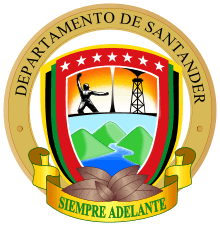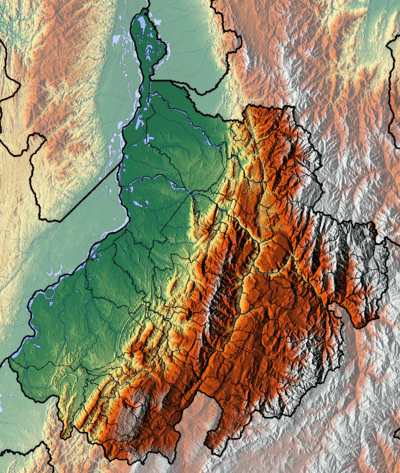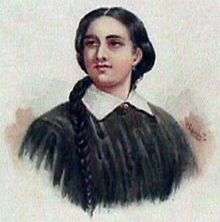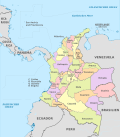Santander Department
Santander (Spanish pronunciation: [santanˈdeɾ]) is a department of Colombia. Santander inherited the name of one of the nine original states of the United States of Colombia. It is located in the central northern part of the country, borders the Magdalena River to the east, Boyacá to the south and southeast, the Norte de Santander Department to the northeast, the Cesar Department to the north, and the Bolivar and Antioquia Departments to the west. Its capital is the city of Bucaramanga.
Department of Santander Departamento de Santander | |
|---|---|
 Coat of arms | |
| Motto(s): Santandereanos siempre adelante (Spanish: People of Santander always ahead) | |
| Anthem: Himno de Santander | |
.svg.png) Santander shown in red | |
 Topography of the department | |
| Coordinates: 7°8′N 73°0′W | |
| Country | |
| Region | Andean Region |
| Established | May 13, 1857 |
| Capital | Bucaramanga |
| Largest city | Bucaramanga |
| Government | |
| • Governor | Didier Alberto Tavera Amado (2016-2019) (Liberal Party) |
| Area | |
| • Total | 30,537 km2 (11,790 sq mi) |
| Area rank | 12th |
| Population (2018)[1] | |
| • Total | 2,184,837 |
| • Rank | 7th |
| • Density | 72/km2 (190/sq mi) |
| Time zone | UTC-05 |
| ISO 3166 code | CO-SAN |
| Provinces | 8 |
| Municipalities | 87 |
| HDI (2017) | 0.758[2] high · 8th |
| Website | gobernaciondesantander.gov.co |
History
Pre-Columbian era
Prior to the arrival of the Spaniards, the territory now known as Santander was inhabited by Amerindian ethnic groups: Muisca, Chitareros, Laches, Yariguí, Opón, Carare and Guanes.
Their political and social structure was based on cacicazgos, a federation of tribes led by a cacique, with different social classes. Their main activity was planting maize, beans, yuca, arracacha, cotton, agave, tobacco, tomato, pineapple, guava, among others. Their agricultural skills were sufficiently developed to take advantage of the different mountainous terrains. The Guanes utilized terraces and an artificial system of irrigation. They had a knowledge of arts and crafts based on ovens to produce ceramics. They had cotton to make clothing and accessories such as hats and bags.
Colonization
Spanish conqueror Antonio de Lebrija led the first expedition through the area in 1529. The area was later invaded c. 1532 by German Ambrosius Ehinger in a quest to find El Dorado. This disrupted or destroyed many of the Amerindian villages. Some ethnic groups like the Yariguíes, Opones, and Carares fought the conquerors until they became extinct. Explorer Gonzalo Jiménez de Quesada later went to the area in an effort to appease the tribes. The colonization process in the area was started by Martín Galeano who founded the village of Vélez on July 3, 1539 and Pedro de Ursúa and Ortún Velázquez de Velasco founded the village of Pamplona (now part of the Norte de Santander Department) in 1549.
Once the Amerindian tribes were dominated, the Spanish organized the territory based on Cabildos (councils) to maintain the dominance and administer justice in the conquered territory. Amerindians were assimilated and subject to the encomienda regime to work in agriculture, manufacturing goods, and mines. These two villages functioned as centers for the Cabildos' territories. In 1636 the Cabildo of Vélez was transferred to a new jurisdiction centered on the village of Girón, with an area which went from the Sogamoso River, Río del Oro to the Magdalena River. The village of San Gil was created in 1689, segregated from the Jurisdiction of Vélez. In 1789 the village of Socorro was also segregated from Vélez and they were all put under the mandate of the Province of Tunja, a subdivision of the Viceroyalty of New Granada. On July 9, 1795 the corregimiento of Vélez – San Gil – Socorro was created due to the unsustainability of the Province of Tunja, and local government was established in the village of Socorro.
Culture
| Year | Pop. | ±% |
|---|---|---|
| 1973 | 1,127,999 | — |
| 1985 | 1,511,392 | +34.0% |
| 1993 | 1,811,741 | +19.9% |
| 2005 | 1,957,789 | +8.1% |
| 2018 | 2,184,837 | +11.6% |
| Source:[3] | ||
During the colony and independence war times, people from Santander were specially recognized for their bravery in battle and their policy of "not even a step back". Soldiers from Santander were valued and respected but also difficult to control as they were, in general, more politically aware than people from other regions and therefore prone to question orders and law. Nowadays, they still retain those features as 'Santandereanos' are normally depicted as cranky and stubborn, not afraid of anything, proud in extreme and speaking their minds without further consideration. However, people from Santander are also very gentle and kind, have some social conventions of basic etiquette like saying hello first if you are the one arriving and never visiting someone for the first time without a small present. In general, they are normally warm and respectful, but try not to make them angry.
Cuisine
Santander cuisine, referred to as santandereas, includes regional specialties and food from the Department's capital city of Bucaramanga and other cities such as Cepita.
Dishes
- Arepa Santandereana, corn cake with salt and pork
- Arroz de Peñaflor
- Empanadas Santandereana, local empanada
- Hormigas culonas, roasted "big butted" ants; the winged ants used are especially abundant in March and April
- Carne oreada, thin steak
- Sobrebarriga
- Fricassee Santandereana, a preparation of viscera and blood of goat mixed with white rice and accompanied with roasted goat ribs.
- "Bocadillo Veleño" Guava sweet and milk sweet mixed in a roll-shaped wrapping.
- Arepa de 'pelao'. Yellow corn cake made of specially ground corn.
- Sobrebarriga tamales
- Carne seca
- Cabrito; goat; cabrito is meat from a kid (baby goat).
- Mute (food), a soup of various grains and meat together with cow's viscera.
- Changua, milk and egg broth
- Fritanga, fried beef, sausage, viscera and blood sausage snacks
- Pepitoria, rice with goat intestine and goat blood
- Chorizos del Valle de San José, a chorizo specialty
- Yuca
Beverages
- Chicha de maiz, chicha from maize
- Chicha de corozo, chicha from palm nut
- Masato Fermented rice drink.
- Goat milk
- Guarapo
- Aguardiente, alcoholic beverage made from sugarcane (White rum)
- Panela's limonada, lemonade drink with sugar cane.
Artists
The most outstanding and representative artists of the Colombian Santander department are Segundo Agelvis, Mario Hernández Prada, Carlos Gómez Castro, Martín Quintero, Oscar Rodríguez Naranjo and Pacheco de Suratá.
Notable people

- Manuela Beltrán was a Neogranadine woman who organized a peasant revolt against excess taxation in 1780
- María Antonia Santos Plata (1782 in Pinchote – 1819 in Socorro, Santander) was a Neogranadine peasant, rebel leader and heroine
- Ofelia Uribe de Acosta (1900 in Oiba – 1988 in Bogota) was a Colombian suffragist.
- Oscar Rodríguez Naranjo (1907–2006) a painter from Socorro, Santander Department, Colombia. His works include mainly oil paintings and sculptures
- José de Jesús Pimiento Rodríguez (born 1919 in Zapatoca) is a Colombian Prelate of the Catholic Church. At the age of 98, he is the oldest living cardinal
- Virginia Gutiérrez de Pineda (1921 in El Socorro, Santander - 1999 in Bogotá) was a Colombian anthropologist who pioneered work on Colombian family and medical anthropology
- Reiner Bredemeyer (1929 − 1995) was a German composer. He was born in Vélez, Santander and went to school in Breslau
- Carlos Ardila Lülle (born in Bucaramanga) is a Colombian entrepreneur and the founder and head of the Organización Ardila Lülle.
- Geo von Lengerke (1827 − 1882) was a German engineer, merchant and landowner.
- Carlos Prada Sanmiguel (1939−2013) a Colombian Roman Catholic bishop.
- Patricia Ariza (born in 1948 in Vélez, Santander) a Colombian poet, playwright and actor
- Juan Eloy Valenzuela y Mantilla was a Colombian priest and botanist who was a person very important during the Royal Botanical Expedition to New Granada which classified plants and wildlife.
Administrative divisions
Provinces
The department is subdivided into provinces:
Municipalities
- Aguada
- Albania
- Aratoca
- Barbosa
- Barichara
- Barrancabermeja
- Betulia
- Bolívar
- Bucaramanga
- Cabrera
- California
- Capitanejo
- Carcasí
- Cepitá
- Cerrito
- Charalá
- Charta
- Chima
- Chipatá
- Cimitarra
- Concepción
- Confines
- Contratación
- Coromoro
- Curití
- El Carmen
- El Guacamayo
- El Peñón
- El Playón
- Encino
- Enciso
- Florián
- Floridablanca
- Galán
- Gámbita
- Girón
- Guaca
- Guadalupe
- Guapotá
- Guavatá
- Güepsa
- Hato
- Jesús María
- Jordán
- La Belleza
- Landázuri
- La Paz
- Lebrija
- Los Santos
- Macaravita
- Málaga
- Matanza
- Mogotes
- Molagavita
- Ocamonte
- Oiba
- Onzaga
- Palmar
- Palmas Socorro
- Páramo
- Piedecuesta
- Pinchote
- Puente Nacional
- Puerto Parra
- Puerto Wilches
- Rionegro
- Sabana de Torres
- San Andrés
- San Benito
- San Gil
- San Joaquín
- San José de Miranda
- San Miguel
- Santa Bárbara
- Santa Helena del Opón
- San Vicente de Chucurí
- Simacota
- Socorro
- Suaita
- Sucre
- Suratá
- Tona
- Valle de San José
- Vélez
- Vetas
- Villanueva
- Zapatoca
References
- "Estimaciones de Población 1985 - 2005 y Proyecciones de Población 2005 - 2020 Total Municipal por Área (estimate)". Departamento Administrativo Nacional de Estadística. Retrieved 16 January 2016.
- "Sub-national HDI - Area Database - Global Data Lab". hdi.globaldatalab.org. Retrieved 2018-09-13.
- "Reloj de Población". DANE. Departamento Administrativo Nacional de Estadísitica. Retrieved 6 July 2017.
External links
| Wikimedia Commons has media related to Santander Department. |
| Wikivoyage has a travel guide for Santander, Colombia. |
.svg.png)
